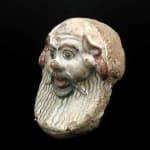Etruscan terracotta antefix with satyr's head, 500 BCE - 400 BCE
Painted Terracotta
5.5
LO.920
An antefix (from the Latin verb “antefigere”, to fasten before) is a vertical component positioned on the terminal part of a tile above the eave along Ithe sides of a...
An antefix (from the Latin verb “antefigere”, to fasten before) is a vertical component positioned on the terminal part of a tile above the eave along Ithe sides of a building. On important buildings the face of each antefix was richly carved and/or painted with vivid colours. In less grand buildings mold-made ceramic antefixae, usually of terracotta, would be then decorated with figures or heads either of humans or mythological creatures or other such ornaments. Etruscans spent a lot of effort decorating their houses, and had a deep appreciation of civic beauty. This antefix was evidently made, as one of many, on a very early production line. This would have given a pleasing effect of uniformity along the roof top. As well as being decorative, architectural terracottas served to cover and protect exposed wooden parts of the architecture from the weather elements. On the present example, the moulded head with furrowed brow has a pair of pointed ears, a long beard and moustache, with red and black painted details. These protective revetments were at first painted, but soon they took the form of polychrome reliefs. Due to their fragility they frequently had to be replaced, although, when decorating temples, they were not allowed to leave the sanctuary precinct. Hence large quantities of architectural fragments have been preserved because they were not meant to be disposed of but buried instead in special pits (bothroi) on the site.
For architectural terracottas the artists used coarse, unrefined impasto which was usually covered with a light coloured slip as a foundation for the painted decoration. The reliefs were usually made in moulds and fired after painting. It was then during the Hellenistic period that antefixes prevalently featured the faces of maenads or sileni (satyrs), such as this one illustrated.
The custom of covering wooden buildings with coloured terracottas was dominant throughout Etruria, Latium and Campania from the 7th century BC up to the Roman period, and the town of Caere must have been a specially important centre in archaic and Classical times, given the archaeological evidence.
For architectural terracottas the artists used coarse, unrefined impasto which was usually covered with a light coloured slip as a foundation for the painted decoration. The reliefs were usually made in moulds and fired after painting. It was then during the Hellenistic period that antefixes prevalently featured the faces of maenads or sileni (satyrs), such as this one illustrated.
The custom of covering wooden buildings with coloured terracottas was dominant throughout Etruria, Latium and Campania from the 7th century BC up to the Roman period, and the town of Caere must have been a specially important centre in archaic and Classical times, given the archaeological evidence.



